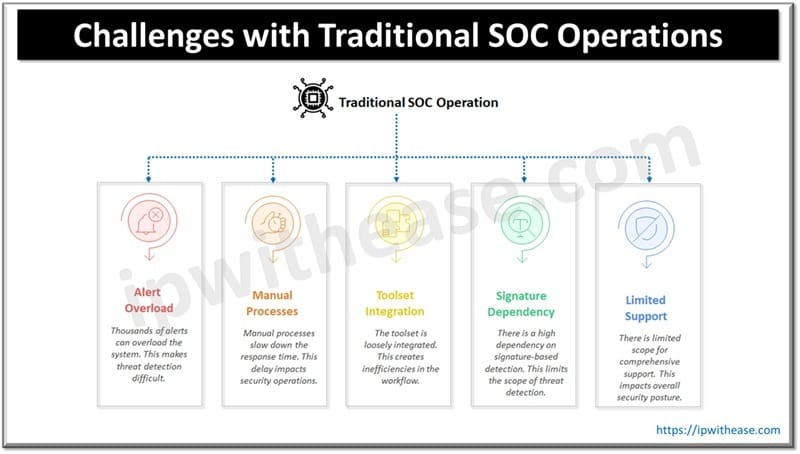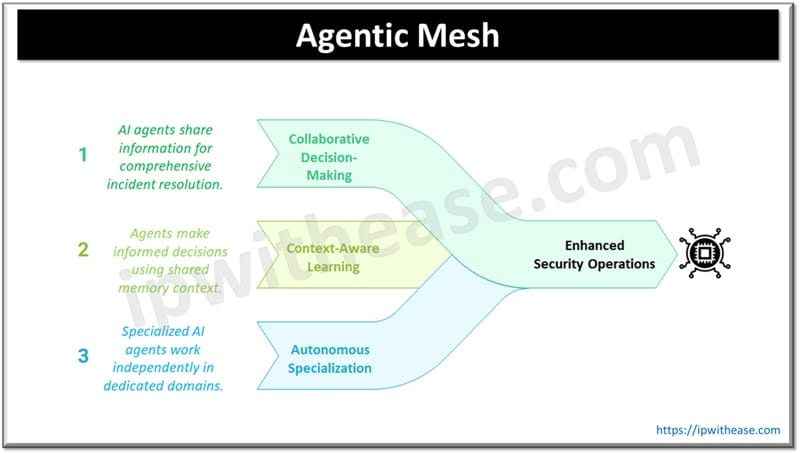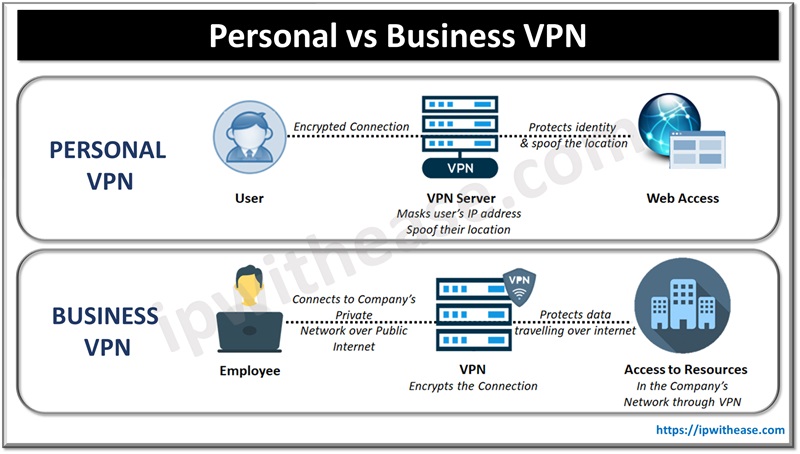Table of Contents
Agentic Mesh is a term used in the context of AI systems and autonomous agents. It represents a dynamic network of interconnecting and collaborating AI agents who interact, communicate and coordinate with each other to accomplish intricate jobs, often across arrays for varied environments or systems.
This article is meant to discuss how Agentic Mesh enables security via decentralized autonomous agents, lowering the high level of reliance on a single point of control. This framework addresses issues related to centralized bottlenecks, helps improve resilience and adaptive threat response.
While autonomous in their tasks, each agent within the Agentic Mesh collaborates with others, forming an interconnected web that ensures no incident is overlooked.
The SOC Revolution (Threat Landscape)
Shortly after the Internet revolution started (in 1990s) and it became available to the public, cyber threats like phishing, worms and threats to financial institutions started popping up. This gave way to the concept of dedicated SOC, an abbreviation for Security Operations Centre. The key functions of SOC have been the same i.e. –
- Incident logging, reporting and compliance
- Continuous and real time monitoring
- Triaging incidents and their reporting
- Real time Threat detection
Over the years, SOC based attack detection and proactive reporting has protected organizations and prevented losses to organizations by making sure that service uptime is kept high and reliable. However, with recent technological advancement in SOC automation, the attack dynamics have transformed. Powered by OmniSence (AI Super engine), it aligns the autonomous AI agents to detect, respond, and learn to render faster evolution than the threats faced. SARA, an autonomous L1 Analyst powered by AI, tirelessly investigates incidents, assists in decision-making, and suggests actionable steps, ensuring rapid response times without overloading security teams.

Why Traditional SOCs Are Breaking Down
But before diving in, lets comprehend the challenges with tradition SOC operations –
- Overload due to alerts in multiples of thousands
- Increased errors while manually differentiating such a large alert quantity.
- Actual threats may be ignored.
- Manual processes delay the response time
- Triaging, correlating led to delay in incident response
- Longer MTTR, upto tens of hours.
- Loosely integrated toolset
- Limited or no correlation from different log sources like SIEM, Firewall etc
- Segmented view since it lacked end to end visibility which could provide a common view relating info from all the sources.
- High dependency on signature-based detection
- Constraints in achieving complete diagnosis of Zero day and behavioural anomalies related attacks.
- Attackers could leverage human-like behaviour patterns to evade detection.
- Lack of efficacy against adaptive and newer threats.
- Limited scope for Comprehensive support
- 24*7 support could be provided due to understaffing or resource challenges.
SIRP: Making it Real
The above-mentioned impediments with traditional SOC have been addressed by SIRP (AI Powered ecosystem), which is actively delivering the architecture and an AI-native platform designed to keep customer Security operations well ahead of evolving threats. SIRP’s comprehensive security value is underpinned by below pillars –
- AI-Native Security: Crafted for Persistent evolution
- Sara: Autonomous L1 Analyst
- Agentic Mesh: Collaborative security without delays
- LLM Integration: Smarter Contextual Analysis
Automation Wasn’t Enough. Autonomy Is Next.
In order to counter the traditional manual and error prone, there has been a substantial drive towards automating the iterative and time-consuming efforts. Prima facie, it may look like a significant development and value-ridden approach, however more adaptive and advanced cyber attackers are one step ahead, developing ways to bypass predefined, rule-based automation. The ideal approach to counter this situation is to embrace autonomy of AI agents.
AI Agentic don’t just follow the predefined scripts, rather use a three-pronged approach of
- observe,
- learn, and
- evolve
The autonomous AI Agents perform real time operations, adapted to the risk factor thereby allowing analysts to focus on complex decision-making while AI Agents handle the bulk of triage, enrichment, and generate actionable insights.

Inside the Agentic Mesh: A Decentralized Security Brain
A network of goal-driven AI agents collaborates seamlessly to handle security operations, and the AI agents performing all this are called Agentic Mesh. It’s the entire army of AI agents collaborating to attain one objective i.e. protect the IT ecosystem. Let’s understand the 3 key traits of Agentic Mesh –
- Collaborative Decision-Making: while AI agents work in specific domains, their hallmark is to share the information and work collaboratively across the whole incident lifecycle i.e. from detection till it is resolved. Such an arrangement begets building a closed-loop security where AI agents are interdependent on each other’s output.
- Context aware learning: Due to its innate nature, Agentic Mesh’s shared memory or context, allows agents to make decisions with a comprehensive view of past events and current state. This renders adaptive and accurate decision taking.
- Autonomous and specialized: Specialized, purpose-built AI agents in large numbers work independently of each other. They are built to perform jobs in dedicated domains like Triage, remediation and investigation etc. notably, they work without a central coordinator, diligently following a goal-based approach.
Conclusion
The ever-changing IT landscape brings more advanced and adaptive threats, which manual processes and automation can’t address. Agentic Mesh is the best-in-class solution which builds on a decentralized network of autonomous agents that analyse, anticipate, and then counters in real time. It would be appropriate to encapsulate that Agentic Mesh provisions a more resilient, adaptive, and proactively intelligent security lifecycle for assets. SIRP is pioneering this transformation through OmniSense™, the world’s first AI-native, self-evolving security automation platform.
ABOUT THE AUTHOR
IPwithease is aimed at sharing knowledge across varied domains like Network, Security, Virtualization, Software, Wireless, etc.



